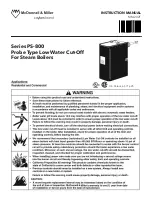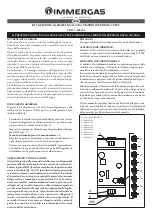
6
EN
TECHNICAL PASSPORT INSTALLATION and OPERATION MANUAL
3. FUEL
All pellets are biomass manufactured from common
low-growing plants and trees. The most common
household type pellets are made of sawdust and
milled wood chippings which are waste material
from wood used in the production of logs, furniture
and other products. Wood is the richest raw material
which does not have any impact on the production
costs of food products or ethyl alcohol (ethanol).
The raw material is processed under high-pressure
and temperature and is pressed to produce small-
size cylindrical pellets. The production process may
utilize soft wood material (such as softwood, pine),
hardwood (oak) as well as recycled waste wood.
Wood pellets are produced in hammer mills or wood
pellet plants.
Advantages of wood pellets:
Convenient storage.
Pellet bags can be stored on a small area in a dry
garage, basement, service room or shed.
Easy loading.
In most cases the boiler hopper needs loading only
once a week – this depends on the hopper capacity.
Better control of fuel quantity.
The small size of the pellets allows for precise fuel
feeding. On the other hand, the supply of air for
reaching optimal combustion efficiency is easier
to adjust since the fuel quantity in the combustion
chamber remains constant and predictable.
Fuel efficiency.
High combustion efficiency is also determined
by consistently low moister content of pellets
(consistently under 10% as opposed to 20% to 60%
moisture content of the logs). Low moisture content,
controlled fuel portions and precise air setting means
high combustion efficiency and very low carbon
oxides in the flue gases.
i
When purchasing pellets, ask for
conformity declaration and certificate
issued by an accredited laboratory
and make sure the fuel meets the
requirements indicated in the manual.
If you purchase large amount of pellets
(bulk supply for the entire heating season
for example), ask your supplier to provide
accurate and true information about the
storage conditions.
We recommend to use pellet with size of 6 - 8 mm.
Density 600 - 750 kg/m
3
heating value 4.7-5.5 kWh/
kg. Ash content – less than 1% and moisture content
up to 8%., EN 14961-2:2011.
The optimal density of the pellets which guarantees
their quality is 605-700 kg per cubic meter.
Pellet moisture content must not exceed 10%. Make
sure you store your fuel in a dry and well-ventilated
place.
The optimal pellet ash content is ≤ 1%. This also
provides for less frequent cleaning intervals for the
burner.
The table below contains the parameters which we
recommend that you take into consideration when
choosing fuel for your Pell burner.
Table 3. European Certification of Wood Pellets for Heating Purposes
Parameters
Units
ENplus-A1
ENplus-A2
EN-B
Diameter
mm
6 (± 1)
8 (± 1)
6 (± 1)
8 (± 1)
6 (± 1)
8 (± 1)
Length
mm
15 ≤ L ≤ 40
1)
15 ≤ L ≤ 40
1)
15 ≤ L ≤ 40
1)
Bulk density
kg / m
2
≥ 600
≥ 600
≥ 600
Calorific/heating value
MJ / kg
≥ 16,5-19
≥ 16,3-19
≥ 16,0-19
Humidity /moisture
Ма .-%
≤ 10
≤ 10
≤ 10
Dust
Ма .-%
≤ 1
3)
≤ 1
3)
≤ 1
3)
Mechanical durability
Ма .-%
≥ 97,5
4)
≥ 97,5
4)
≥ 96,5
4)
Ash
Ма .-%
2)
≤ 0,7
≤ 1,5
≤ 3,5
Melting point of ash
°C
≥ 1200
≥ 1100
-
Chlorine content
Ма .-%
2)
≤ 0,02
≤ 0,02
≤ 0,03
Sulfur content
Ма .-%
2)
≤ 0,03
≤ 0,03
≤ 0,04
Nitrogen content
Ма .-%
2)
≤ 0,3
≤ 0,3
≤ 1,0
Copper content
mg / kg
2)
≤ 10
≤ 10
≤ 10
Summary of Contents for Burnit PelleBurn 15
Page 58: ...58 Diagrams Schemes Schémas 1 3 2 4 5 ...
Page 59: ...59 Diagrams Schemes Schémas 5 1 6 45o ...
Page 61: ...61 Diagrams Schemes Schémas 9 10 CHPUMP RT room thermostat TTOP TBOTTOM CHPUMP ...
Page 65: ...65 Diagrams Schemes Schémas 23 23 1 U H D V W1 Z O Т F P M W2 D K W F P L J B L A N B ...
Page 66: ...66 Diagrams Schemes Schémas 24 25 26 27 ...
Page 67: ......







































